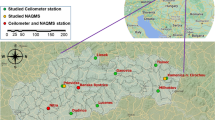Abstract
Air pollution predictions often require the height of atmospheric mixed layer in time especially in big cities. Here, the variation of the height of this layer is estimated from direct measurements and also from a numerical forecast model with a high resolution boundary layer scheme. The height of the daytime mixed layer for the city of Zanjan (48.5°N, 36.7°E, 1700m above sea level) is measured using a LIDAR (532 nm) system, which works based on aerosols scattering of laser light. The mixed layer height (z i ) for Zanjan city, well above mean sea level compared to other major cities in the world, is found to be between 1.4 km typically in spring and 2.2 km in summer, for synoptic calm conditions. Also, the MM5 forecast model with a proper boundary layer scheme (MRF) is used to estimate z i which shows rather good agreement with direct observations using the LIDAR system. The entrainment zone of the mixed layer was also found to undergo some occasional temporal growth that may be attributed to shear instability that led to more mixed layer growth.
Similar content being viewed by others
References
Ahmadi Givi F and Sabetghadam S 2006 Sensitivity Analysis of MM5 Weather Forecasting Model to the choice of the planetary boundary layer scheme for estimating mixed layer depth; Sixth Numerical Weather Prediction Conference, December 2006, Tehran, Iran.
Bidokhti A A and Britter R E 2002 A large stratified shear flow water channel facility; Exp. Fluids 33 281–287.
Bidokhti A A and Khoshsima M 2006 Non-uniform entrainment at a density interface near a continuous stratified fluid in a confined region; Proceedings of the Eleventh Asian Congress of Fluid Mechanics, 22–25 May 2006, Kuala Lumpur, Malaysia.
Boers R E, Eloranta W and Coulter R L 1984 LIDAR observations of mixed layer dynamics: Tests of parameterized entrainment models; J. Climate Appl. Meteor. 23 247–266.
Cohn S A and Angevine W M 2000 Boundary-layer height and entrainment zone thickness measured by LIDARs and wind profiling radars; J. Appl. Meteor. 39 1233–1247.
Driedonks A G M and Tennekes H 1984 Entrainment effects in the well-mixed atmospheric boundary layer; Bound. Layer Meteor. 30 75–105.
Fedorovich E and Conzemius R 2008 Effects of wind shear on the atmospheric convective boundary layer structure and evolution; Acta Geophysica 56 114–141.
Flamant C and Flamant P 1997 LIDAR determination of the entrainment zone thickness at the top of the unstable marine atmospheric boundary layer; Bound. Layer Meteor. 83 247–284.
Flamant C and Pelon J 1996 Boundary layer structure over the Mediterranean during Tramontane event; Quart. J. Roy. Meteor. Soc. 122 1741–1778.
Hanna S 1982 A handbook on atmospheric diffusion, US Department of Commerce.
Hogrefe C, Rao S T, Kasibhatla P, Kallos G, Tremback C J and Hao W 2001 Evaluating the performance of regionalscale photochemical modeling systems: Part I. Meteorological predictions; Atmos. Environ. 35 4159–4174.
Holzworth G 1967 Mixing depths, wind speeds and air pollution potential from selected locations in the United States; J. Appl. Met. 6 1039–1044.
Hong S Y and Pan H L 1996 Nonlocal boundary layer vertical diffusion in a medium-range forecast model; Mon. Wea. Rev. 124 2322–2339.
Itsweire E C, Helland K N and Van Atta C W 1986 The evolution of grid-generated turbulence in a stably stratified fluid; J. Fluid Mech. 162 299–338.
Khalesifard H R M, Faridian A, Abdi F and Flamant P H 2004 532-NM Elastic Backscatter LIDAR Station Operated in Northwest Iran for Environmental Studies, In: 22nd International Laser Radar Conference (ILRC 2004); Proceedings of the Conference held 12–16 July, 2004 in Matera, Italy (eds) Gelsomina Pappalardo and Aldo Amodeo, ESA SP-561. Paris: European Space Agency, p. 423.
Kunkel K E, Eloranta W and Shipley S T 1977 LIDAR observations of the convective boundary layer; J. Appl. Meteor. Soc. 16 1306–1311.
Marsik F J, Fischer K W, McDonald T D and Samon P J 1992 Comparison of the methods for estimating mixing height used during the 1992 Atlanta field intensive; J. Appl. Meteor. 34 1802–1814.
Mason P 1989 Large-eddy simulation of the convective atmospheric boundary-layer; J. Atmos. Sci. 46(11) 1492–1516.
McGarth J I, Fernando H J S and Hunt J C R 1997 Turbulence, waves and mixing near free shear density interfaces, Part 2 Laboratory experiments; J. Fluid Mech. 347 197–234.
Melfi S H, Spinhirne J D, Chou S H and Palm S P 1985 LIDAR observations of vertically organized convection in the planetary boundary layer over the ocean; J. Climate Appl. Meteor. 24 806–821.
Nelson E, Stull R B and Eloranta E W 1989 A prognostic relationship for entrainment zone thickness; J. Appl. Meteor. 28 885–903.
Newsom R K and Banta R M 2003 Shear-Flow Instability in the Stable Nocturnal Boundary Layer as Observed by Doppler Lidar during CASES-99; J. Atmos. Sci. 60 16–33.
Pino D and Arellano V 2004 The Boundary Layer Growth in an Urban Area; Science of the Total Environment, 334–335 207–213.
Rocadenbosch F 2003 Lidar-Aerosol Sensing; In: Encyclopedia of Optical Engineering (ed.) Dekker M, 1st edn., New York; 1090–1102.
Seaman N L 2000 Meteorological modeling for air quality assessments; Atmos. Environ. 34 2231–2259.
Stull R B 1988 An introduction to boundary layer meteorology (Dordrecht: Kluwer Academic Publishers).
Stull R B and Eloranta E W 1984 Boundary layer experiment 1983; Bull. Amer. Meteor. Soc. 65 450–456.
Tomasi D and Perrone M 2005 PBL and dust layer evolution by lidar and radiosounding measurement over peninsular site; Atmos. Res. 80(1) 86–103.
Troen I and Mahrt L 1986 A simple model of the atmospheric boundary layer sensitivity to surface evaporation; Bound. Layer Meteor. 43 129–148.
Wetzel P J 1982 Toward parameterization of the stable boundary layer; J. Appl. Met. 21 7–13.
Author information
Authors and Affiliations
Corresponding author
Rights and permissions
About this article
Cite this article
Bidokhti, A.A., Khoshsima, M., Sabetghadam, S. et al. Estimation of urban mixed layer height in Zanjan using LIDAR observations and numerical modeling. J Earth Syst Sci 117, 925–934 (2008). https://doi.org/10.1007/s12040-008-0077-z
Received:
Revised:
Accepted:
Published:
Issue Date:
DOI: https://doi.org/10.1007/s12040-008-0077-z




